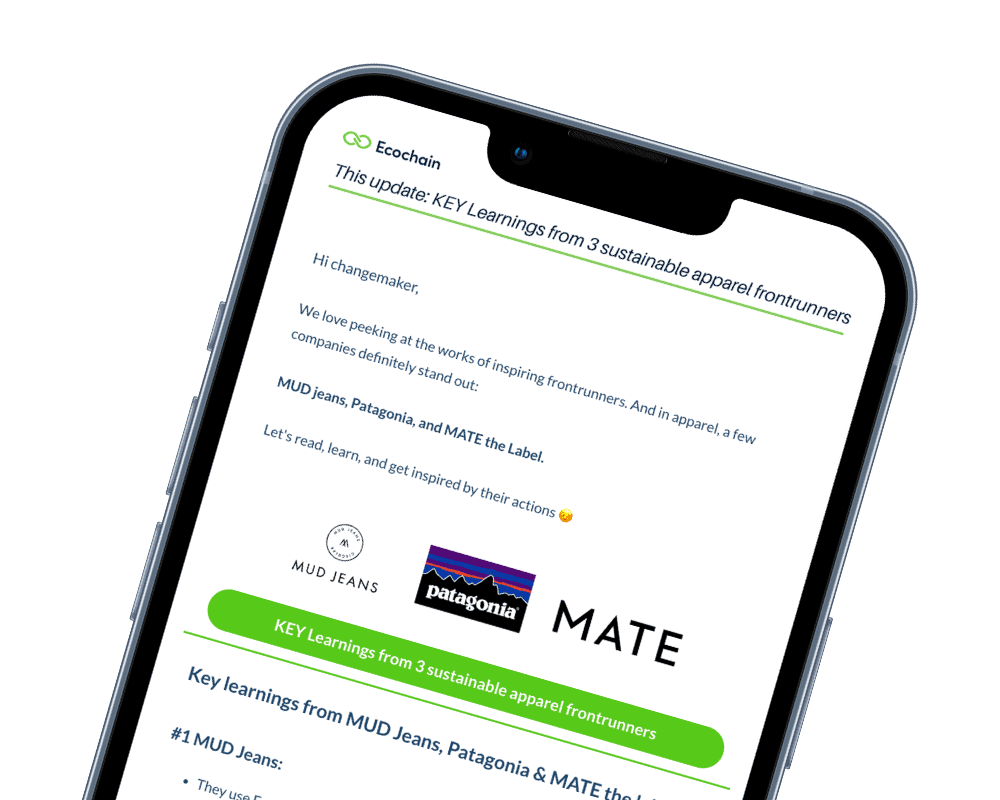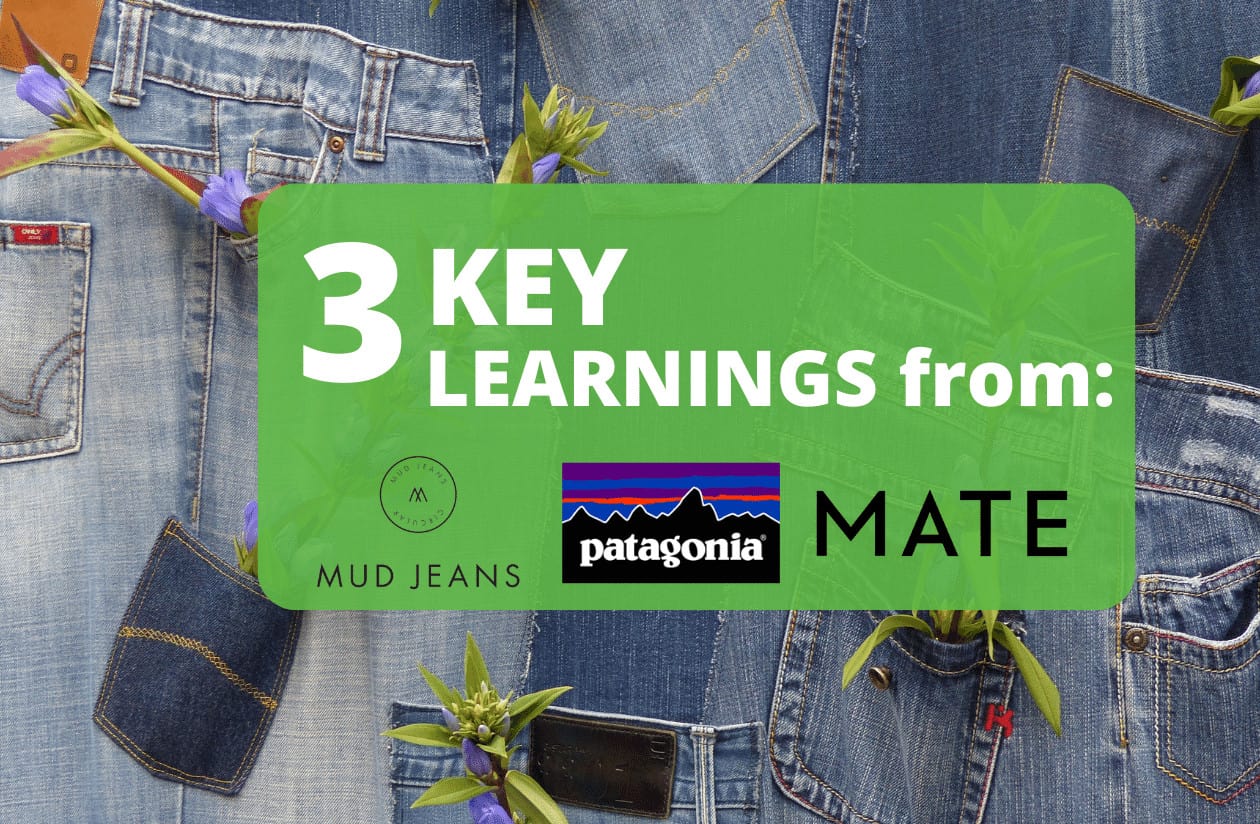Sometimes, learning about sustainable apparel is like going to school again. And like in school, there are those straight-A students that blurt out the answers while you still try to understand the question.
What answers do MUD jeans, Patagonia, and MATE the label frontrunners have regarding sustainable apparel?
Fancy a peek at their homework?
In this article, we study the concrete actions that make these companies frontrunners. And how you can adopt their underlying values of innovation, communication, and accountability.
#1 Mud Jeans: Innovative To The Core
We find MUD jeans in the lab, the one with the glasses and the calculator. As a natural–science nerd, Mud jeans is intensely data-driven about their innovation. By using LCA software Helix they measured all environmental impacts of their products. And then geeked out in chemistry and physics.
In one of their factories, you can drink purified laundry water. Also, their other factories only discard clean water- Hasta la vista, water pollution.
They produce their jeans with minimum energy and harmful chemicals. Or ditched those chemicals completely: they make their jeans look cool with lasers and ozone. Not only better for the environment but also the worker’s health!
Their jeans fabrics are made from Global Organic Textile Standard cotton and recycled cotton. Cotton that they themselves recycled out of old denim. This avoids environmental impacts! They get the old denim by taking back their old jeans. And those of other brands, too!
And if it’s not the end of life for a pair just yet, they offer free repairs on their products in the first 12 months.
Main learning: Innovating the details of your production process can have several benefits at once. Ask yourself: what does this process achieve, and is there a smarter way to do this?
Get inspired by their innovative techniques and circularity initiatives here.

Mud Jeans – the world’s first 100% circular denim brand. Copyrights: MUD Jeans.
#2 Patagonia: Customer Communication Heroes
Outdoor brand Patagonia is the public speaker of the class. Even better, the teacher sometimes asks them to give the class. They really make sure their customers and everyone else understand that all products, even theirs, have impacts on the environment.
“I tell you this as CEO of a clothing company that, despite a deep commitment to responsible manufacturing, still takes more from the earth than it returns.”
Rose Marcario, Patagonia CEO
They tell their customers to not buy their products (if they do not absolutely need them), to repair their clothing, and to keep using them for a long time. Sustainability needs not only aware brands but aware customers. In this, Patagonia helps its customers with a never-expiring-free repair guarantee and DIY repair tutorials.
Despite (or maybe because of) calling everyone out, they became immensely popular! And all this “unwanted” attention generates profits. Those are brought to a good cause:
- 1% of each sale is given to environmental nonprofits and -grassroots organizations. Patagonia considers this “paying rent for our use of the planet”. This initiative is called “1% for the planet” and was founded by the legendary Patagonia founder Yvon Chouinard himself. Any business can join them!
- Patagonia made international headlines in September 2022: Chouinard and his family transferred ownership of the company. By creating a new type of ownership structure, they still hold decision power, but earth is now [their] only shareholder”. All net profits, after reinvestment in the business, will be used to fight the climate- and environmental crisis! That’s what we call putting your money where your mouth is.
They seem more like a mission with a clothing company than the other way around. But after all, they still design products (even if they last a lifetime). Read more about their designs, recycled fabrics, and ethically sourced animal fibers here.
Main learning: Your customers are just as important in your sustainability journey – as any of your big impact reduction efforts. Did you already look into the impact of customers using your product?
Get the #1 newsletter on environmental sustainability in fashion & apparel.
Receive stories of sustainable change makers and practical insights on how to reduce the environmental footprint of your products.
We protect your data.
#3 MATE the label: Transparent And Accountable About Impact
MATE is a USA-based women’s-brand with men’s and kids’ collections. In our sustainable-apparel class, they are the kids that do their homework spotlessly! They:
- Use only organic, natural, & non-toxic fabrics.
- Avoid plastics in their products and packaging,
- Clean up their waste, even the invisible.
Invisible waste, you wonder? We all emit it: CO2. By measuring scope 1, 2, and 3 emissions they know exactly how much they cause. And then pay to offset those emissions. This makes their products climate-neutral certified! And is a self-imposed incentive to produce less CO2 intensely.
And instead of letting you send their products to waste at the end of their life, they ask you to send them back. They recycle them, along with the fabric scraps from the cutting table, into new yarn, to be given a second life.
Regarding neat homework: their impact report is extremely transparent about their CO2 emissions. You will find the numbers both for their product types and fabrics. They openly tell you (Patagonia nods approvingly in the background) that their emissions grow because they are growing. They also tell you exactly where they can trace their supply chain, and it’s impressive!
Lastly, just like Patagonia, they give back 1% of their sales to environmental non-profits. Customers can choose one of four inspiring initiatives to do good through their purchase. With these initiatives and the offsetting projects, they support many ecological and social causes. A small but smashing company!
Main learning: Clear and transparent communication on your sustainability efforts is crucial to create understanding among all your stakeholders. Always ask yourself the question: if I were our consumers – would I understand your communication efforts? What would I want- and need to know?
What All 3 Frontrunners Have In Common
All three brands:
- Choose the more sustainable fabric options, e.g. organic cotton over conventional cotton.
- Take responsibility for their products beyond their end-of-life by re- or-up-cycling them.
All these good deeds make MUD and Patagonia certified B-corps (MATE is in the process of becoming one). Being a B-corp is like a golden star from the teacher, for being a general social and environmental do-good-er.
And the best thing: you can collect the required 80 points for people and the planets in your own unique way.
Sustainable product design has never been easier with Mobius.
READ MORE ABOUT MOBIUS
External references
- What is a B-corp: https://www.bcorporation.net/en-us/certification
- 1% for the planet: https://onepercentfortheplanet.org/
- Why repair: https://patagonia.medium.com/repair-is-a-radical-act-4af2b651887b
- Organic textile standard: https://global-standard.org/the-standard/philosophy
Sign up for our sustainability newsletter:
We do the research.
You make sustainable apparel.
Join 7000+ sustainability leaders who read our sustainability newsletter.



